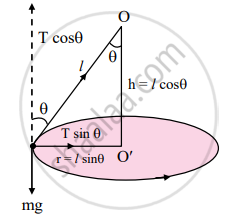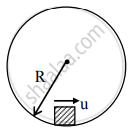Advertisements
Advertisements
Question
Answer the following question.
Show that its time period is given by, 2π`sqrt((l cos theta)/("g"))` where l is the length of the string, θ is the angle that the string makes with the vertical, and g is the acceleration due to gravity.
Solution

Conical pendulum
Where,
O: rigid support,
T: tension in the string,
l: length of string,
h: height of support from bob,
v: velocity of bob,
r: radius of horizontal circle,
θ: semi-vertical angle,
mg: weight of bob
- Consider a bob of mass m tied to one end of a string of length ‘l’ and the other end is fixed to a rigid support.
- Let the bob be displaced from its mean position and whirled around a horizontal circle of radius ‘r’ with constant angular velocity ω, then the bob performs U.C.M.
- During the motion, string is inclined to the vertical at an angle θ as shown in the figure above.
- In the displaced position, there are two forces acting on the bob.
a. The weight mg acting vertically downwards.
b. The tension T acting upward along the string. - The tension (T) acting in the string can be resolved into two components:
a. T cos θ acting vertically upwards.
b. T sin θ acting horizontally towards centre of the circle. - Since there is no net force, the vertical component T cos θ balances the weight and the horizontal component T sin θ provides the necessary centripetal force.
∴ T cos θ = mg ....(1)
T sin θ = `"mv"^2/"r" = "mr"omega^2` ....(2) - Dividing equation (2) by (1),
tan θ = `"v"^2/"rg"` ....(3)
Therefore, the angle made by the string with the vertical is θ = tan-1 `("v"^2/"rg")` - Since we know v = `(2pi"r")/"T"`
∴ tan θ = `(4pi^2"r"^2)/("T"^2"rg")` ....[From (3)]
T = `2pi sqrt("r"/("g"tan theta))`
T = `2pi sqrt((l sin theta)/("g"tan theta)) ....[because "r" = l sin theta]`
T = `2pi sqrt((l cos theta)/("g"))`
T = `2pi sqrt("h"/"g")` .....(∵ h = l cos θ)
where l is length of the pendulum and h is the vertical distance of the horizontal circle from the fixed point O.
APPEARS IN
RELATED QUESTIONS
A particle rotates in U.C.M. with tangential velocity V along a horizontal circle of diameter ‘D' . Total angular displacement of the particle in time 't' is..........
A stone tied to the end of a string 80 cm long is whirled in a horizontal circle with a constant speed. If the stone makes 14 revolutions in 25 s, what is the magnitude and direction of acceleration of the stone?
Read the statement below carefully and state, with reason, if it is true or false:
The acceleration vector of a particle in uniform circular motion averaged over one cycle is a null vector.
Is it possible to have an accelerated motion with a constant speed? Explain
Explain the meaning of uniform circular motion. Give one example of such motion.
A uniform linear motion is unaccelerated, while a uniform circular motion is an accelerated motion.
Name the force required for uniform circular motion. State its direction.
Define Uniform circular motion.
Answer the following question.
Define angular velocity.
Solve the following problem.
A projectile is thrown at an angle of 30° to the horizontal. What should be the range of initial velocity (u) so that its range will be between 40m and 50 m? Assume g = 10 m s-2.
A particle performs uniform circular motion in a horizontal plane. The radius of the circle is 8 cm. The centripetal force acting on the particle is 15 N. Its kinetic energy is ____________.
A particle is moving in uniform circular motion with speed 'V' and radius 'R'. The angular acceleration of the particle is ______.
A particle is perfonning uniform circular motion. If 'θ', 'ω', 'α' and ' a' are its angular displacement, angular velocity, angular acceleration, and centripetal acceleration respectively, then which of the following is 'WRONG'?
A ball of mass 'm' is attached to the free end of an inextensible string of length 'l'. Let 'T' be the tension in the string. The ball is moving in horizontal circular path about the vertical axis. The angular velocity of the ball at any particular instant will be ______.
A mass 'm' is tied to one end of a spring and whirled in a horizontal circle with constant angular velocity. The elongation in the spring is 1 cm. If the angular speed is doubled, the elongation in the spring is 6 cm. The original length of the spring is ______.
Two particles P and Q are moving in concentric circles of rarui rp and rQ respectively. If their period of revolutions are in ratio 2 : 3, then ratio of their centripetal acceleration is ____________.
The given graph represents motion with ______ speed.
A body moves in a uniform circular motion ______.
Which of the following is correct about uniform circular motion
- the direction of motion is continuously changed
- the direction of motion is not changed
- speed and direction both remain constant
- speed is constant but the direction is changing
A body is said to be in nonuniform motion if it travels ______.
In uniform motion, an object travels equal ______ in ______ interval of time.
It is possible to have objects moving with uniform velocity but non-uniform acceleration.
A particle is given an initial speed u inside a smooth spherical shell of radius R = 1 m that it is just able to complete the circle. Acceleration of the particle when its velocity is vertical is ______.

A wet open umbrella is held upright and is rotated about the handle at a uniform rate of 21 revolutions in 44 s. If the rim of the umbrella is a circle of 1 metre in diameter and the height of the rim above the floor is 1.5 m, the drops of water spun off the rim and hit the floor at a horizontal ______ m from the umbrella.
A wheel rotating at the same angular speed undergoes constant angular retardation. After the revolution, angular velocity reduces to half its initial value. It will make ______ revolution before stopping.
A thin uniform circular disc of mass M and radius R is rotating in a horizontal plane about an axis passing through its centre and perpendicular to its plane with an angular velocity ω. Another disc of same dimensions, but of mass `1/4`M is placed gently on the first disc co-axially. The. angular velocity of the system is ______.
Why is uniform circular motion said to be accelerated?
